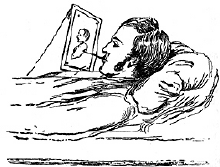John Carter - lip artist

Born to humble parents on 31st July 1815 he first attended a dame’s school in Church Street, leaving at the age of 10 for the National school in Stoneham Street until 1828 whereupon he finished his education at the Sir Robert Hitcham endowed school. He showed no particular indications of his talent to come save for some scribblings of animals and birds in his school books.
After leaving school he was employed by the silk manufacturing company of Beckwith in Back Lane as a weaver for weekly wages of about 12 shillings. Although he married in 1835, aged 20, he had fallen in with the wrong crowd, and so it was that on one Saturday night in May 1836, shortly before his 21st birthday, he and his mischievous companions found themselves attracted to the rookery at Holfield Grange. Having climbed to a height of about 40 feet a branch gave way and he fell to the ground, knocked unconscious. His friends carried him home on a hurdle by a circuitous route to avoid walking past the gamekeeper’s house. He was never to walk again, his whole body being completely paralysed from below the neck. At first he was not expected to live but he slowly began to recover all his faculties save the ability to move.
Six weeks after the accident he and his wife moved to his father’s house for convenience where he then spent several months in total despair. He passed much of his time reading, until one day his wife brought to him a little biography of a young woman called Elizabeth Kinning. She was an inmate of an asylum in Liverpool who, having lost the use of her hands, had taught herself to draw with her mouth. This idea excited him and he immediately began to practice, at first using a slate, then by having paper pinned to his pillow and using a pencil and then water colours. His skill increased apace and encouraged by a Miss Hanbury from Holfield Grange, who sold his early drawings for one shilling, he had to decide upon a style to adopt. He decided upon line drawings where he would first sketch with a pencil and then fill in the fine detail with Indian ink using a fine-hair pencil. The posture he adopted to carry out his work was by lying on his side with his head slightly raised by his pillows. A small, light desk, made under his own instructions, was adjusted for him, the paper being pinned to it.
|
|
A portrait of John Carter by Rev. W. J. Dampier, Vicar of Coggeshall |
He only ever drew while in bed and only in the company of family and those he knew well as he said that strangers made him so nervous that he could not trust himself with the delicate brush strokes. The brush was constantly taken out of his mouth and refilled by an attendant, most often his wife, and his delicacy of touch and the precision of his work under the most extremely difficult conditions is stunning. A constant stream of people would bring subjects to him for copying but the artist always considered his best picture to be a drawing called “Innocence” by Hermann Winterhalter, done for a Miss White at Highfields. Another of his drawings was presented to the dowager Queen Adelaide, wife of William IV, by the Bishop of London, and was passed on to Queen Victoria. He seldom pursued his art during the winter months as he considered the light was unsatisfactory.
He was attended on primarily by his wife Lucy until 1841 but she died prematurely in that year from heart disease. From this time onward his sister Hannah Carter succeeded his wife and became John’s constant companion and attendant. She would regularly push him out in the summertime, many visits being made to the parish church. It was one of these sojourns that tragically accelerated his demise. Wishing to give his sister a break from pushing him, he arranged for his carriage to be drawn by a small boy and a visiting relative. Unfortunately the boy lost control and the carriage turned over. John Carter never recovered from this fall and within two weeks, at the age of 35, his life was over.

Two more works by John Carter

